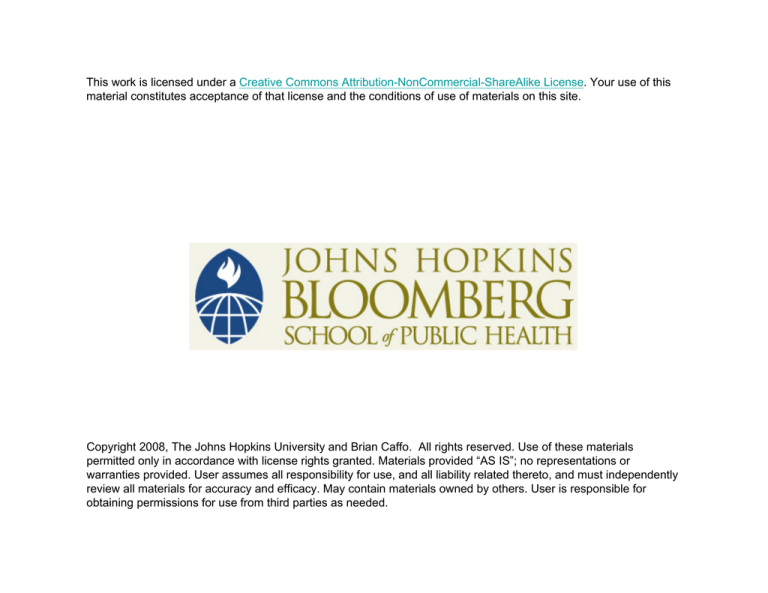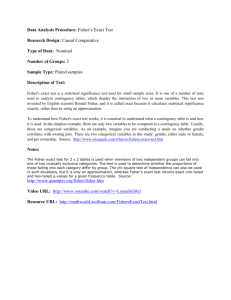
This work is licensed under a Creative Commons Attribution-NonCommercial-ShareAlike License. Your use of this
material constitutes acceptance of that license and the conditions of use of materials on this site.
Copyright 2008, The Johns Hopkins University and Brian Caffo. All rights reserved. Use of these materials
permitted only in accordance with license rights granted. Materials provided “AS IS”; no representations or
warranties provided. User assumes all responsibility for use, and all liability related thereto, and must independently
review all materials for accuracy and efficacy. May contain materials owned by others. User is responsible for
obtaining permissions for use from third parties as needed.
Lecture 21
Brian Caffo
Table of
contents
Outline
Fisher’s exact
test
The hypergeometric
distribution
Fisher’s exact
test in practice
Monte Carlo
Lecture 21
Brian Caffo
Department of Biostatistics
Johns Hopkins Bloomberg School of Public Health
Johns Hopkins University
December 19, 2007
Lecture 21
Table of contents
Brian Caffo
Table of
contents
Outline
Fisher’s exact
test
The hypergeometric
distribution
Fisher’s exact
test in practice
1 Table of contents
2 Outline
3 Fisher’s exact test
Monte Carlo
4 The hypergeometric distribution
5 Fisher’s exact test in practice
6 Monte Carlo
Lecture 21
Brian Caffo
Table of
contents
Outline
Fisher’s exact
test
The hypergeometric
distribution
Fisher’s exact
test in practice
Monte Carlo
1
Introduce Fisher’s exact test
2
Illustrate Monte Carlo version of test
Lecture 21
Brian Caffo
Fisher’s exact test
Table of
contents
Outline
Fisher’s exact
test
The hypergeometric
distribution
Fisher’s exact
test in practice
Monte Carlo
• Fisher’s exact test is “exact” because it guarantees the α
rate, regardless of the sample size
• Example, chemical toxicant and 10 mice
Tumor None Total
Treated
4
1
5
Control
2
3
5
Total
6
4
• p1 = prob of a tumor for the treated mice
• p2 = prob of a tumor for the untreated mice
Lecture 21
Continued
Brian Caffo
Table of
contents
Outline
Fisher’s exact
test
The hypergeometric
distribution
Fisher’s exact
test in practice
Monte Carlo
• H0 : p1 = p2 = p
• Can’t use Z or χ2 because SS is small
• Don’t have a specific value for p
Lecture 21
Fisher’s exact test
Brian Caffo
Table of
contents
Outline
Fisher’s exact
test
The hypergeometric
distribution
Fisher’s exact
test in practice
Monte Carlo
• Under the null hypothesis every permutation is equally
likely
• observed data
Treatment : T T T T T C C C C C
Tumor
: T T T T N T T N N N
• permuted
Treatment : T C C T C T T C T C
Tumor
: N T T N N T T T N T
• Fisher’s exact test uses this null distribution to test the
hypothesis that p1 = p2
Lecture 21
Brian Caffo
Hyper-geometric distribution
Table of
contents
Outline
Fisher’s exact
test
The hypergeometric
distribution
Fisher’s exact
test in practice
Monte Carlo
• X number of tumors for the treated
• Y number of tumors for the controls
• H0 : p1 = p2 = p
• Under H0
• X ∼ Binom(n1 , p)
• Y ∼ Binom(n2 , p)
• X + Y ∼ Binom(n1 + n2 , p)
Lecture 21
Continued
Brian Caffo
Table of
contents
Outline
Fisher’s exact
test
The hypergeometric
distribution
Fisher’s exact
test in practice
P(X = x | X + Y = z) =
Monte Carlo
This is the hypergeometric pmf
n1
x
n2
z −x
n1 + n2
z
Lecture 21
Proof
Brian Caffo
Table of
contents
Outline
Fisher’s exact
test
The hypergeometric
distribution
P(X = x) =
Fisher’s exact
test in practice
Monte Carlo
p x (1 − p)n1 −x
n2
z −x
n1 + n2
z
P(Y = z − x) =
P(X + Y = z) =
n1
x
p z−x (1 − p)n2 −z+x
p z (1 − p)n1 +n2 −z
Lecture 21
Continued
Brian Caffo
Table of
contents
Outline
Fisher’s exact
test
The hypergeometric
distribution
P(X = x | X + Y = z) =
P(X = x, X + Y = z)
P(X + Y = z)
=
P(X = x, Y = z − x)
P(X + Y = z)
=
P(X = x)P(Y = z − x)
P(X + Y = z)
Fisher’s exact
test in practice
Monte Carlo
Plug in and finish off yourselves
Lecture 21
Fisher’s exact test
Brian Caffo
Table of
contents
Outline
Fisher’s exact
test
The hypergeometric
distribution
Fisher’s exact
test in practice
Monte Carlo
• More tumors under the treated than the controls
• Calculate an exact P-value
• Use the conditional distribution = hypergeometric
• Fixes both the row and the column totals
• Yields the same test regardless of whether the rows or
columns are fixed
• Hypergeometric distribution is the same as the
permutation distribution given before
Lecture 21
Tables supporting Ha
Brian Caffo
Table of
contents
Outline
Fisher’s exact
test
The hypergeometric
distribution
Fisher’s exact
test in practice
Monte Carlo
• Consider Ha : p1 > p2
• P-value requires tables as extreme or more extreme (under
Ha ) than the one observed
• Recall we are fixing the row and column totals
• Observed table
4 1 5
Table 1 = 2 3 5
6 4
• More extreme tables in favor of the alternative
5 0 5
Table 2 = 1 4 5
6 4
Lecture 21
Calculations
Brian Caffo
Table of
contents
Outline
Fisher’s exact
test
The hypergeometric
distribution
Fisher’s exact
test in practice
P(Table 1) = P(X = 4|X + Y = 6)
5
5
4
2
=
= 0.238
10
6
Monte Carlo
P(Table 2) = P(X = 5|X + Y = 6)
5
5
5
1
=
= 0.024
10
6
P-value = 0.238 + 0.024 = 0.262
Lecture 21
Brian Caffo
R code
Table of
contents
Outline
Fisher’s exact
test
The hypergeometric
distribution
Fisher’s exact
test in practice
Monte Carlo
dat <- matrix(c(4, 1, 2, 3), 2)
fisher.test(dat, alternative = "greater")
------------------output---------------Fisher’s Exact Test for Count Data
data: dat
p-value = 0.2619
alt hypoth: true odds ratio is greater than 1
95 percent confidence interval:
0.3152217
Inf
sample estimates:
odds ratio
4.918388
Lecture 21
Notes
Brian Caffo
Table of
contents
Outline
Fisher’s exact
test
The hypergeometric
distribution
Fisher’s exact
test in practice
Monte Carlo
• Two sided p-value = 2×one sided P-value
(There are other methods which we will not discuss)
• P-values are usually large for small n
• Doesn’t distinguish between rows or columns
• The common value of p under the null hypothesis is called
a nuisance parameter
• Conditioning on the total number of successes, X + Y ,
eliminates the nuisance parameter, p
• Fisher’s exact test guarantees the type I error rate
• Exact unconditional P-value
sup P(X /n1 > Y /n2 ; p)
p
Lecture 21
Monte Carlo
Brian Caffo
Table of
contents
Outline
Fisher’s exact
test
The hypergeometric
distribution
Fisher’s exact
test in practice
Monte Carlo
• Observed table X = 4
Treatment : T T T T T C C C C C
Tumor
: T T T T N T T N N N
• Permute the second row
Treatment : T T T T T C C C C C
Tumor
: T N T N T T N N T T
• Simulated table X = 3
• Do over and over
• Calculate the proportion of tables for which the simulated
X ≥4
• This proportion is a Monte Carlo estimate for Fisher’s
exact P-value






